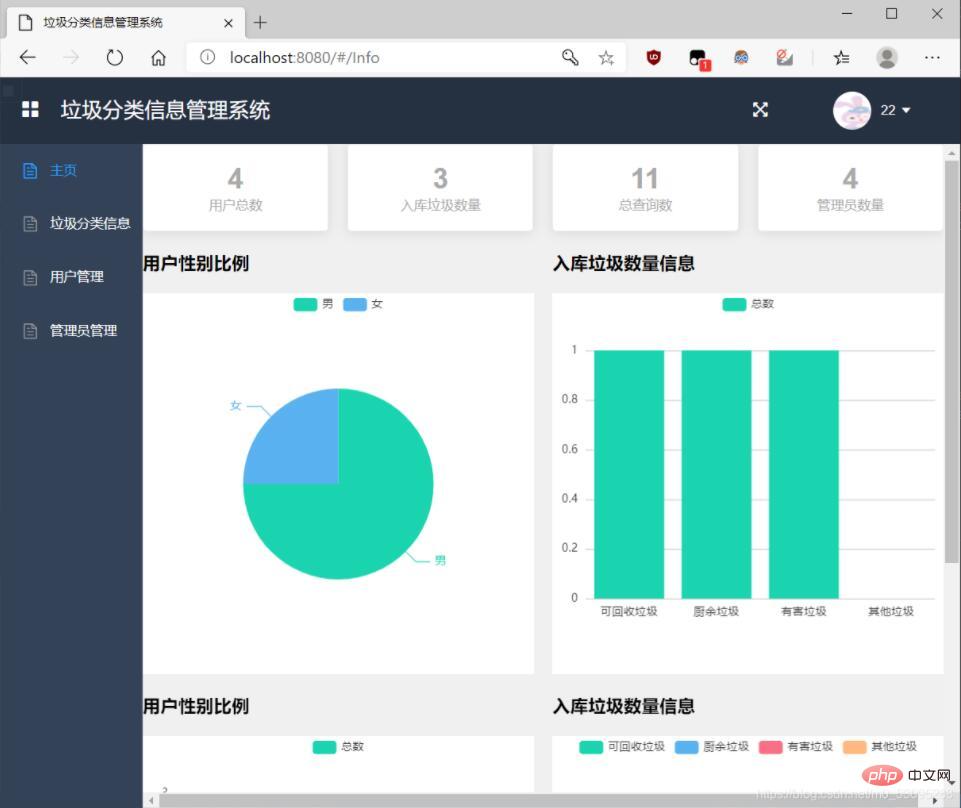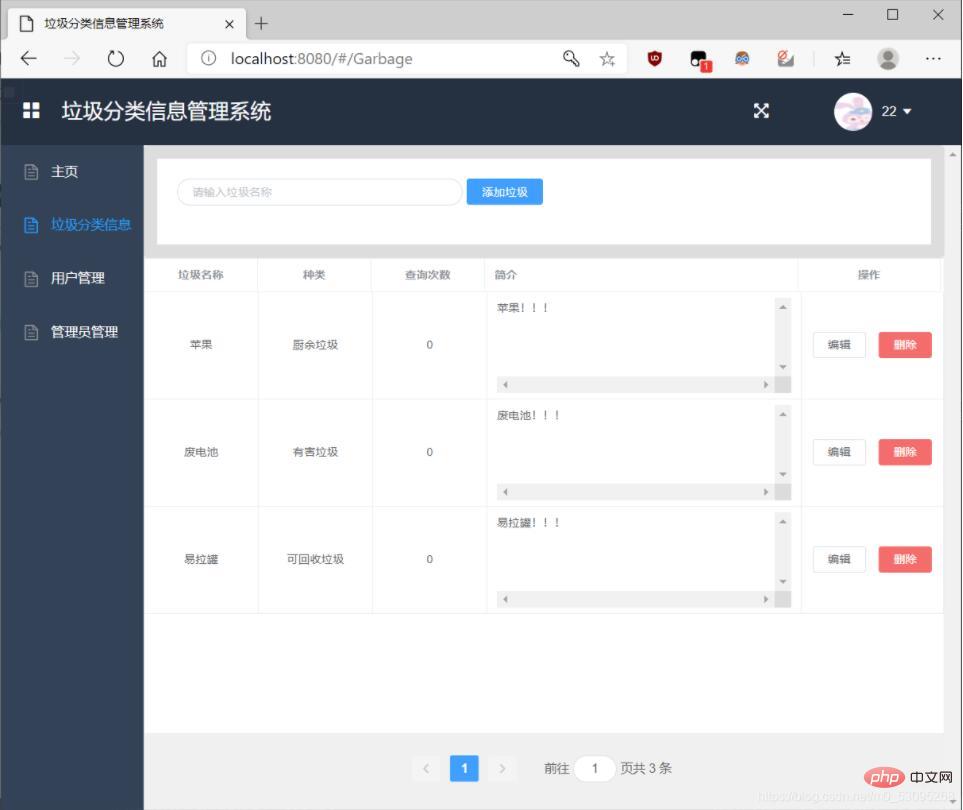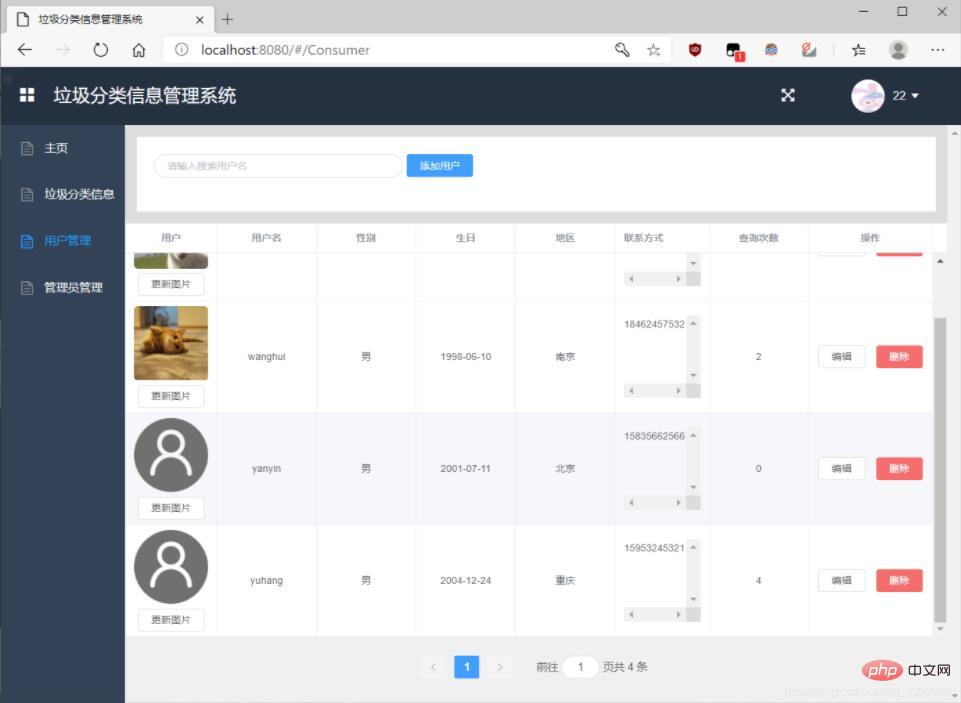ホームページ >Java >&#&チュートリアル >springboot+vueをベースにしたガベージ分類管理システムの実装方法
springboot+vueをベースにしたガベージ分類管理システムの実装方法
- WBOYWBOYWBOYWBOYWBOYWBOYWBOYWBOYWBOYWBOYWBOYWBOYWB転載
- 2023-05-12 10:01:191170ブラウズ
1. プロジェクトの概要
1. プロジェクトの内容
このプロジェクトでは、IDEA、Visual Studio Code 開発ツール、および Mysql、Navicat for MySQL ツールを使用して、A を達成します。 springboot vue に基づくガベージ分類管理システム。システムは、ユーザーと管理者の 2 種類のユーザーにサービスを提供します。
2. 機能の実装
(1) ログイン機能
データベースとの接続を確立した後、データベース内のユーザーと管理者はログインできます。アカウント番号とパスワードを入力してページにログインします。
(2) データの追加・確認・変更・削除機能
①ゴミの追加・確認・変更・削除
②管理者による追加・確認・変更delete
③ ユーザーの追加、確認、変更、削除
(3) ユーザーの男女比、ストレージ内のゴミの量、総数を円グラフや棒グラフで表示します。ユーザー数、管理者の総数、ストレージ内のゴミの量、クエリの数などを表示できます。
2. 特定の実装
1. フロントエンド ログイン インターフェイス
<template>
<div class="login-wrap">
<div class="ms-title">垃圾分类信息管理系统</div>
<div class="ms-login">
<el-form :model="ruleForm" :rules="rules" ref="ruleForm">
<el-form-item prop="username">
<el-input v-model="ruleForm.username" placeholder="用户名"></el-input>
</el-form-item>
<el-form-item prop="password">
<el-input type="password" v-model="ruleForm.password" placeholder="密码"></el-input>
</el-form-item>
<div class="login-btn">
<el-button type="primary" @click="submitForm">登录</el-button>
</div>
</el-form>
</div>
</div>
</template>
<script>
import {mixin} from "../mixins/index";
import {getLoginStatus} from "../api/index";
export default {
mixins:[mixin],
data: function(){
return {
ruleForm:{
username: "admin",
password: "123"
},
rules:{
username:[
{required:true,message:"请输入用户名",trigger:"blur"}
],
password:[
{required:true,message:"请输入密码",trigger:"blur"}
]
}
};
},
methods:{
submitForm(){
let params = new URLSearchParams();
params.append("name",this.ruleForm.username);
params.append("password",this.ruleForm.password);
getLoginStatus(params)
.then((res) =>{
if(res.code == 1){
this.$router.push("/Info");
this.notify("登录成功","success");
}else{
this.notify("登录失败","error");
}
});
}
}
}
</script>2. 実装の追加、削除、変更、確認
(1) 管理者情報の追加、削除、変更の確認
/**
* 添加管理员
**/
@RequestMapping(value = "/add",method = RequestMethod.POST)
public Object addAdminGuanli(HttpServletRequest request){
JSONObject jsonObject = new JSONObject();
String name = request.getParameter("name").trim();
String username = request.getParameter("username").trim();
String password = request.getParameter("password").trim();
String pic = request.getParameter("pic").trim();
String location = request.getParameter("location").trim();
String introduction = request.getParameter("introduction").trim();
//保存到管理员的对象中
AdminGuanli adminGuanli = new AdminGuanli();
adminGuanli.setName(name);
adminGuanli.setUsername(username);
adminGuanli.setPassword(password);
adminGuanli.setPic(pic);
adminGuanli.setLocation(location);
adminGuanli.setIntroduction(introduction);
boolean flag = AdminGuanliService.insert(adminGuanli);
if(flag){
jsonObject.put(Consts.CODE,1);
jsonObject.put(Consts.MSG,"添加成功");
return jsonObject;
}
jsonObject.put(Consts.CODE,0);
jsonObject.put(Consts.MSG,"添加失败");
return jsonObject;
}
/**
* 修改管理员
**/
@RequestMapping(value ="/update",method = RequestMethod.POST)
public Object updateAdminGuanli(HttpServletRequest request){
JSONObject jsonObject = new JSONObject();
String id = request.getParameter("id").trim();
String name = request.getParameter("name").trim();
String username = request.getParameter("username").trim();
String password = request.getParameter("password").trim();
String location = request.getParameter("location").trim();
String introduction = request.getParameter("introduction").trim();
//保存到管理员的对象中
AdminGuanli adminGuanli = new AdminGuanli();
adminGuanli.setId(Integer.parseInt(id));
adminGuanli.setName(name);
adminGuanli.setUsername(username);
adminGuanli.setPassword(password);
adminGuanli.setLocation(location);
adminGuanli.setIntroduction(introduction);
boolean flag = AdminGuanliService.update(adminGuanli);
if(flag){
jsonObject.put(Consts.CODE,1);
jsonObject.put(Consts.MSG,"修改成功");
System.out.println("11111111111111111");
return jsonObject;
}
jsonObject.put(Consts.CODE,0);
jsonObject.put(Consts.MSG,"修改失败");
return jsonObject;
}
/**
* 删除管理员
**/
@RequestMapping(value ="/delete",method = RequestMethod.GET)
public Object deleteAdminGuanli(HttpServletRequest request){
String id = request.getParameter("id").trim();
boolean flag = AdminGuanliService.delete(Integer.parseInt(id));
return flag;
}
/**
* 查询管理员
**/
@RequestMapping(value ="/selectByPrimaryKey",method = RequestMethod.GET)
public Object selectByPrimaryKey(HttpServletRequest request){
String id = request.getParameter("id").trim();
return AdminGuanliService.selectByPrimaryKey(Integer.parseInt(id));
}
@RequestMapping(value ="/allAdminGuanli",method = RequestMethod.GET)
public Object allAdminGuanli(HttpServletRequest request){
return AdminGuanliService.allAdminGuanli();
}
@RequestMapping(value ="/AdminGuanliOfName",method = RequestMethod.GET)
public Object AdminGuanliOfName(HttpServletRequest request){
String name = request.getParameter("name").trim();
return AdminGuanliService.AdminGuanliOfName("%"+name+"#");
}
/**
* 更新管理员图片
**/
@RequestMapping(value ="/updateAdminPic",method = RequestMethod.POST)
public Object updateAdminPic(@RequestParam("file") MultipartFile avatorFile, @RequestParam("id")int id){
JSONObject jsonObject = new JSONObject();
if(avatorFile.isEmpty()){
jsonObject.put(Consts.CODE,0);
jsonObject.put(Consts.MSG,"文件上传失败");
return jsonObject;
}
//文件名=当前时间到毫秒+原来文件名
String fileName = System.currentTimeMillis()+avatorFile.getOriginalFilename();
//文件路径
String filePath = System.getProperty("user.dir")+System.getProperty("file.separator")+"img"
+System.getProperty("file.separator")+"AdminPic";
//如果文件路径不存在,新增该路径
File file1 = new File(filePath);
if(file1.exists()){
file1.mkdir();
}
//实际文件路径
File dest = new File(filePath+System.getProperty("file.separator")+fileName);
//存储到数据库的相对文件地址
String storeAvatorPath = "/img/AdminPic/"+fileName;
try {
avatorFile.transferTo(dest);
AdminGuanli adminGuanli = new AdminGuanli();
adminGuanli.setId(id);
adminGuanli.setPic(storeAvatorPath);
boolean flag = AdminGuanliService.update(adminGuanli);
if(flag){
jsonObject.put(Consts.CODE,1);
jsonObject.put(Consts.MSG,"上传成功");
jsonObject.put("pic",storeAvatorPath);
return jsonObject;
}
jsonObject.put(Consts.CODE,0);
jsonObject.put(Consts.MSG,"修改失败");
return jsonObject;
} catch (IOException e) {
jsonObject.put(Consts.CODE,0);
jsonObject.put(Consts.MSG,"修改失败"+e.getMessage());
}finally {
return jsonObject;
}
}
}(2) スパム情報の追加、削除、変更の確認
/**
* 添加垃圾信息
**/
@RequestMapping(value="/add",method= RequestMethod.POST)
public Object addGarbage(HttpServletRequest request){
JSONObject jsonObject=new JSONObject();
String name=request.getParameter("name").trim();
String type=request.getParameter("type").trim();
String introduction=request.getParameter("introduction").trim();
//保存到垃圾信息的对象当中
Garbage garbage=new Garbage();
garbage.setName(name);
garbage.setType(type);
garbage.setIntroduction(introduction);
boolean flag=GarbageService.insert(garbage);
if(flag){
jsonObject.put(Consts.CODE,1);
jsonObject.put(Consts.MSG,"添加成功");
return jsonObject;
}
jsonObject.put(Consts.CODE,0);
jsonObject.put(Consts.MSG,"添加失败");
return jsonObject;
}
/**
* 修改垃圾信息
**/
@RequestMapping(value = "/update",method = RequestMethod.POST)
public Object updateGarbage(HttpServletRequest request){
JSONObject jsonObject=new JSONObject();
String id=request.getParameter("id").trim();
String name=request.getParameter("name").trim();
String type=request.getParameter("type").trim();
String introduction=request.getParameter("introduction");
//保存到垃圾信息的对象中去
Garbage garbage=new Garbage();
garbage.setId(Integer.parseInt(id));
garbage.setName(name);
garbage.setType(type);
garbage.setIntroduction(introduction);
boolean flag=GarbageService.update(garbage);
if(flag){
jsonObject.put(Consts.CODE,1);
jsonObject.put(Consts.MSG,"修改成功");
return jsonObject;
}
jsonObject.put(Consts.CODE,0);
jsonObject.put(Consts.MSG,"修改失败");
return jsonObject;
}
/**
* 删除垃圾信息
**/
@RequestMapping(value = "/delete",method = RequestMethod.GET)
public Object deleteGarbage(HttpServletRequest request){
String id=request.getParameter("id").trim();
boolean flag=GarbageService.delete(Integer.parseInt(id));
return flag;
}
/**
* 查询垃圾信息
**/
@RequestMapping(value = "/allGarbage",method = RequestMethod.GET)
public Object allGarbage(HttpServletRequest request){
return GarbageService.allGarbage();
}
}( 3) ユーザー情報の追加・削除・変更の確認
/**
* 添加用户
**/
@RequestMapping(value = "/add",method = RequestMethod.POST)
public Object addUser(HttpServletRequest request){
JSONObject jsonObject = new JSONObject();
String name = request.getParameter("name").trim();
String username = request.getParameter("username").trim();
String password = request.getParameter("password").trim();
String sex = request.getParameter("sex").trim();
String pic = request.getParameter("pic").trim();
String birth = request.getParameter("birth").trim();
String location = request.getParameter("location").trim();
String contact = request.getParameter("contact").trim();
DateFormat dateFormat = new SimpleDateFormat("yyyy-MM-dd");
Date birthDate = new Date();
try {
birthDate = dateFormat.parse(birth);
} catch (ParseException e) {
e.printStackTrace();
}
System.out.println(name);
//保存到用户的对象中
User user=new User();
user.setName(name);
user.setUsername(username);
user.setPassword(password);
user.setSex(new Byte(sex));
user.setPic(pic);
user.setBirth(birthDate);
user.setLocation(location);
user.setContact(contact);
boolean flag = UserService.insert(user);
if(flag){
jsonObject.put(Consts.CODE,1);
jsonObject.put(Consts.MSG,"添加成功");
return jsonObject;
}
jsonObject.put(Consts.CODE,0);
jsonObject.put(Consts.MSG,"添加失败");
return jsonObject;
}
/**
* 修改用户
**/
@RequestMapping(value ="/update",method = RequestMethod.POST)
public Object updateUser(HttpServletRequest request){
JSONObject jsonObject = new JSONObject();
String id = request.getParameter("id").trim();
String name = request.getParameter("name").trim();
String username = request.getParameter("username").trim();
String password = request.getParameter("password").trim();
String sex = request.getParameter("sex").trim();
String pic = request.getParameter("pic").trim();
String birth = request.getParameter("birth").trim();
String location = request.getParameter("location").trim();
String contact = request.getParameter("contact").trim();
DateFormat dateFormat = new SimpleDateFormat("yyyy-MM-dd");
Date birthDate = new Date();
try {
birthDate = dateFormat.parse(birth);
} catch (ParseException e) {
e.printStackTrace();
}
//保存到用户的对象中
User user=new User();
user.setId(Integer.parseInt(id));
user.setName(name);
user.setPassword(password);
user.setSex(new Byte(sex));
user.setPic(pic);
user.setBirth(birthDate);
user.setLocation(location);
user.setContact(contact);
boolean flag = UserService.update(user);
if(flag){
jsonObject.put(Consts.CODE,1);
jsonObject.put(Consts.MSG,"修改成功");
System.out.println("11111111111111111");
return jsonObject;
}
jsonObject.put(Consts.CODE,0);
jsonObject.put(Consts.MSG,"修改失败");
return jsonObject;
}
/**
* 删除用户
**/
@RequestMapping(value ="/delete",method = RequestMethod.GET)
public Object deleteUser(HttpServletRequest request){
String id = request.getParameter("id").trim();
boolean flag = UserService.delete(Integer.parseInt(id));
return flag;
}
/**
* 查询用户
**/
@RequestMapping(value ="/selectByPrimaryKey",method = RequestMethod.GET)
public Object selectByPrimaryKey(HttpServletRequest request){
String id = request.getParameter("id").trim();
return UserService.selectByPrimaryKey(Integer.parseInt(id));
}
@RequestMapping(value ="/allUser",method = RequestMethod.GET)
public Object allUser(HttpServletRequest request){
return UserService.allUser();
}
@RequestMapping(value ="/UserOfName",method = RequestMethod.GET)
public Object UserOfName(HttpServletRequest request){
String name = request.getParameter("name").trim();
return UserService.userOfName("%"+name+"#");
}
/**
* 更新用户图片
**/
@RequestMapping(value ="/updateUserPic",method = RequestMethod.POST)
public Object updateUserPic(@RequestParam("file") MultipartFile avatorFile, @RequestParam("id")int id){
JSONObject jsonObject = new JSONObject();
if(avatorFile.isEmpty()){
jsonObject.put(Consts.CODE,0);
jsonObject.put(Consts.MSG,"文件上传失败");
return jsonObject;
}
//文件名=当前时间到毫秒+原来文件名
String fileName = System.currentTimeMillis()+avatorFile.getOriginalFilename();
//文件路径
String filePath = System.getProperty("user.dir")+System.getProperty("file.separator")+"img"
+System.getProperty("file.separator")+"userPic";
//如果文件路径不存在,新增该路径
File file1 = new File(filePath);
if(file1.exists()){
file1.mkdir();
}
//实际文件路径
File dest = new File(filePath+System.getProperty("file.separator")+fileName);
//存储到数据库的相对文件地址
String storeAvatorPath = "/img/userPic/"+fileName;
try {
avatorFile.transferTo(dest);
User user = new User();
user.setId(id);
user.setPic(storeAvatorPath);
boolean flag = UserService.update(user);
if(flag){
jsonObject.put(Consts.CODE,1);
jsonObject.put(Consts.MSG,"上传成功");
jsonObject.put("pic",storeAvatorPath);
return jsonObject;
}
jsonObject.put(Consts.CODE,0);
jsonObject.put(Consts.MSG,"修改失败");
return jsonObject;
} catch (IOException e) {
jsonObject.put(Consts.CODE,0);
jsonObject.put(Consts.MSG,"修改失败"+e.getMessage());
}finally {
return jsonObject;
}
}
}3. クロスドメイン問題の解決
public class WebMvcConfig implements WebMvcConfigurer {
@Override
public void addCorsMappings(CorsRegistry registry) {
registry.addMapping("/**")
.allowCredentials(true) /*访问是否需要验证*/
.allowedOriginPatterns("*")
.allowedMethods("*");
}
}3. 機能デモ
1フロントエンド URL に従って Web ページ

# にアクセスします。 2. ホームページ

#3 にログインします。スパムメッセージの表示

 #5. 管理者管理ページ
#5. 管理者管理ページ
以上がspringboot+vueをベースにしたガベージ分類管理システムの実装方法の詳細内容です。詳細については、PHP 中国語 Web サイトの他の関連記事を参照してください。

